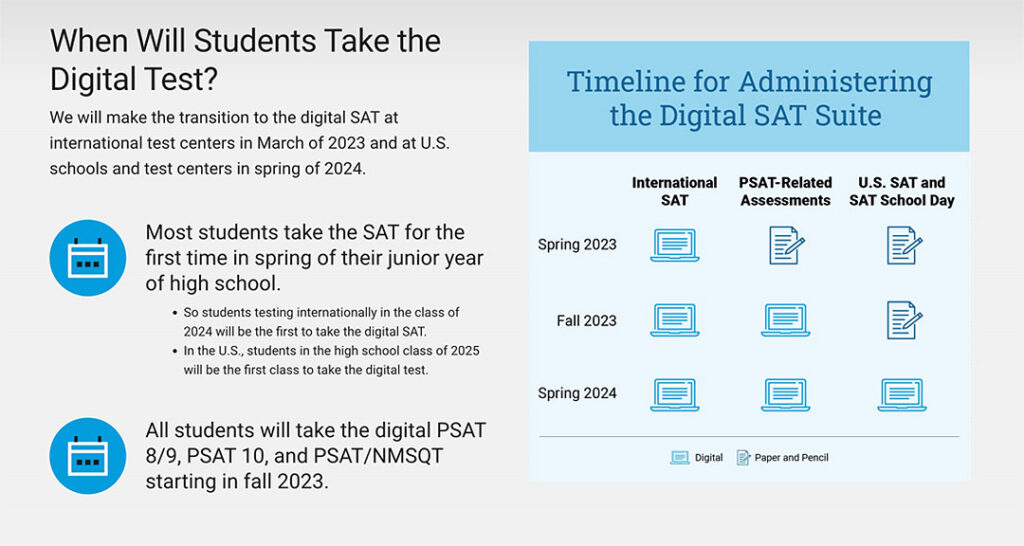Charting the Path to Full Digitalization: PSAT, SAT, and NMSQT Timeline
During the 2023-2024 school year, standardized testing in schools will undergo a significant change. The PSAT, SAT, and NMSQT will be moving from paper and pencil to completely digital formats. This digital transition will revolutionize not only the way students take their tests, but also the way schools prepare for and administer these exams. At Hartford Technology Rental, we understand the challenges and complexities that come with digitalizing standardized testing. That’s why we’re here to help schools chart a clear path to full digitalization, and ensure they have the necessary computer and networking equipment to make the PSAT digital transition and SAT digital test timeline as smooth as possible. In this post, we’ll discuss the timeline for this transition and the steps schools can take to successfully navigate the digitization of standardized testing.
Introduction to Digitalization Plans
As we approach the fall of 2023 and the spring of 2024, schools around the country will undergo a significant change in the administration of standardized tests. The paper and pencil version of the PSAT and SAT will soon be a thing of the past, as they transition into digital forms. This shift towards digitalization presents both opportunities and challenges, as schools must adapt to new testing protocols, train their students, and ensure they have the necessary infrastructure and equipment to administer the tests.
Despite the challenges that come with this transition, there are many benefits to a fully digitalized testing system. Digital tests offer greater accuracy and efficiency in grading, providing students with almost instant feedback on their performance. In addition, digital testing allows for the incorporation of multimedia, such as videos and graphs, that can enhance the learning experience for students.
Schools must also be aware of the potential concerns around digital testing, such as ensuring access to technology and addressing any privacy or security issues that may arise. This is where a company like Hartford Technology Rental can help, by providing schools with the necessary equipment and support to administer the tests efficiently and securely.
While some may be skeptical of this transition to digital testing, it is important to note that the assessments will still be able to accurately assess student knowledge and skills. The College Board, who administers the PSAT and SAT, has conducted extensive research and piloted the digital versions of the tests to ensure they are just as effective as the paper and pencil versions.
The shift towards a fully digitalized testing system presents both challenges and opportunities for schools, but ultimately holds the potential to better measure and enhance student learning. As schools prepare for this transition, it is important to ensure they have the necessary support and infrastructure in place to ensure a successful implementation.
The Evolution of PSAT, SAT, and NMSQT Testing
The SAT and PSAT exams, along with the National Merit Scholarship Qualifying Test (NMSQT), have been a staple of American education for decades. However, the ways in which these exams are administered and graded have changed dramatically over the years. For many years, these exams were administered in a paper-and-pencil format, with students filling out multiple choice answers on a scantron sheet that was then graded by hand.
Over time, the tests became more complex and required larger testing infrastructures to administer and grade accurately. Even with paper tests, accommodation for students with disabilities was available through alternative formats such as braille or audio recordings. However, grading these large-scale exams was a laborious and time-consuming process that often took weeks or months to complete.
In recent years, the College Board, which administers the SAT, PSAT, and NMSQT exams, has been working to transition these exams from paper to digital administration. Through the use of computer adaptive testing, students will now receive more customized tests based on their responses, allowing for more targeted and accurate scoring. Digital administration will also speed up the grading process, providing scores faster and with more accuracy than ever before.
With digital testing, the accommodations for students with disabilities will remain in place, but also with new accommodations available for various situations. Educators can now utilize real-time analytics to see exactly where a student is struggling, allowing them to intervene and provide further support earlier in the testing process. This type of analysis has the potential to lead to better scores and higher quality education outcomes for students.
At Hartford Technology Rental, we are excited to support this transition to digital testing by providing school districts with the necessary equipment and networking tools to administer these large-scale exams. The goal of this transition is to create a more effective and efficient standardized testing process, and we are proud to be a part of this digital transformation of standardized testing.
Milestones in the Digital Transformation
The digital transformation of standardized testing has been a long time coming, with the College Board setting the groundwork for this shift for quite some time. With the introduction of the College Board Digital, an initiative aimed at transforming the delivery and administration of exams and assessments, the organization has been working tirelessly on the development of the College Board’s digital exam plan that will set the stage for the future of standardized testing. This plan has been meticulously crafted to ensure that educators and students alike can take advantage of the benefits of digital testing while maintaining the high standards of accuracy and reliability associated with standardized tests.
The introduction of the International SAT in the spring of 2023 marked a significant milestone in this digital transformation, with the PSAT set to follow in the fall of 2023 and the SAT scheduled to go digital in the spring of 2024. Schools that are leading the charge on digital testing are already beginning to realize the benefits of this shift, with increased efficiency, decreased administrative workload, and improved accessibility for students with different learning styles. However, with any sweeping change of this magnitude, schools must establish their own milestones to ensure that they are properly equipped to implement digital testing in their institutions. This includes investing in reliable technology infrastructure and training staff members on the new protocols and procedures associated with digital testing. By taking these proactive steps, schools can ensure that they are prepared for the future of standardized testing.
College Board’s Strategy for Online Testing
The College Board’s strategy for online testing is to make the entire process more efficient and streamlined for both students and educators. The shift towards digital testing will improve the speed of scoring and grant easier access to test results. In turn, this will allow for the analysis of test data and provide more detailed feedback to students and teachers. The College Board recognizes that implementing standardized testing online gives students greater flexibility and convenience for testing, making test-taking more accessible and equitable for all students.
The College Board also believes that online testing is the next step in standardized testing. They argue that the digital environment provides a more efficient and effective experience compared to traditional paper and pencil tests. Besides providing quicker feedback, online testing allows for automatic scoring, eliminating the possibility of human error while grading. Computerized testing also allows for a more reliable and standardized test-taking experience. Digital tests are exact copies of one another, leaving no possibility for variances in clarity, readability and consistency that can often occur with paper exams. All in all, the College Board feels that transitioning to online testing is a necessary move to align testing with the needs and expectations of today’s digital world.
When Will SAT Go Fully Digital?
The era of paper-based testing is coming to an end, and digital testing is the way of the future. The PSAT, or Preliminary SAT, is set to become completely digital in the fall of 2023, while the SAT is scheduled to follow in the spring of 2024. This transition away from paper-based testing is driven by the need for a more efficient, secure, and reliable way to administer standardized assessments. School districts must prepare for this change as it will be here before they know it. They must ensure that their computer and networking infrastructure is up-to-date and capable of handling the digital testing demands. With the right tools and technology at hand, school districts can smoothly transition to digital testing, without compromising the students’ learning environment. As we draw closer to this new era in standardized testing, we must remain vigilant in our preparations so that our students can benefit from a more streamlined and efficient learning experience.

Source: collegeboard.org
Navigating the Changes to Online Test Taking
The transition has already started to become a topic of conversation in school districts across the country. While the change may seem overwhelming at first, it is important to note that schools will still need to prepare and plan for this shift just like any other large-scale change they’ve faced in recent years. While some districts may already have the necessary technology in place, others will need to rent computer and networking equipment to provide students with the necessary tools to take the exams online.
Another aspect that schools will need to take into account is the way in which student accommodations will be administered during the digital testing process. Although accommodations will still be provided to those who need them, it is likely that the methods used to administer these accommodations will be more computer-based than human-based, as this is the most effective way to ensure that all students receive the assistance they need in a timely manner.
It’s worth noting that the digital tests will be shorter than their paper counterparts, which will likely come as welcome news to many students. This is because digital tests can be formatted in a way that allows students to navigate through the test more efficiently, with less time wasted flipping pages and answering questions that are not relevant to their specific exam.
As school districts begin to navigate this new chapter in standardized testing, it is important to remember that while change can be daunting, it is also an opportunity for growth and adaptation. With the right planning and resources in place, schools can make the transition to digital testing a smooth and successful one for both students and educators alike. At Hartford Technology Rental, we’re committed to helping schools make this transition as seamless as possible.
The Future of Standardized Testing
The future of standardized testing is digital, and it is ever-evolving. The transition from paper and pencil to digital testing is happening across the country, and it is set to stay. The benefits of digital testing are vast and unmatched. Notably, it provides test results and analysis much faster and more accurately than traditional methods. Students and teachers can receive instant feedback on their performance, including a detailed breakdown of their scores and areas of strength and weakness. This creates an opportunity for students to improve their scores and challenges them to work harder to get better results.
As schools adapt to this major shift in testing, it is critical for them to have a plan in place to ensure they have the right computer equipment for digital testing. This is where our company, Hartford Technology Rental, can help. We are experts in providing computer equipment to schools for digital tests. We offer a wide range of computer rental options, including laptops, desktops, tablets, and other digital devices that can help schools administer digital tests with ease.
Our focus on technology has seen us become a reliable partner to schools as we help them navigate this complex transition. We work with schools to understand their needs, and we provide affordable and scalable solutions. Our team of experts provides onsite support on the day of the test, ensuring that everything runs smoothly. Therefore, schools can be assured of a seamless transition to digital testing, without any interruptions or delays. As we continue to innovate to keep up with the ever-evolving digital landscape, we look forward to helping schools provide the best possible digital testing experience.
Conclusion
In conclusion, as technology continues to shape the landscape of education, the transition from paper-and-pencil exams to digital formats is becoming increasingly inevitable. With the PSAT going digital in the fall of 2023 and the SAT following suit in spring 2024, schools across the country are in the process of preparing for this shift. Fortunately, Hartford Technology Rental is here to help. As the preferred equipment provider for schools looking to implement digital testing, we are well-equipped to provide the technology necessary to make this transition as smooth and seamless as possible. From laptops and tablets to Chromebooks and beyond, we have everything schools need to ensure their students are ready to excel in the digital age. So if you’re looking for affordable, reliable technology solutions to help your school succeed, look no further than Hartford Technology Rental!

















